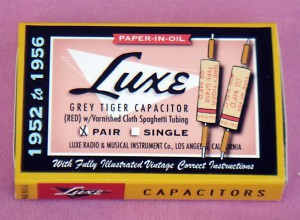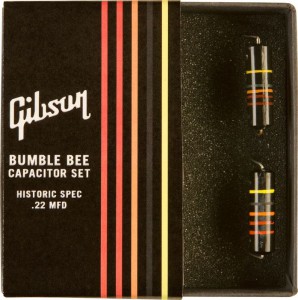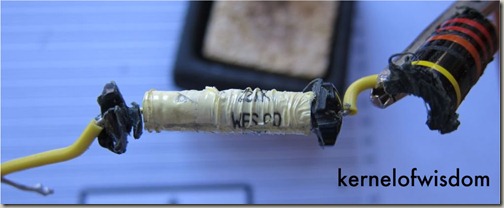The Cap’s New Clothes
Today, let’s take a look at some really fancy boutique tone capacitors. You can hear these in the yesterday’s tone cap shootout.


Have you ever wondered what special manufacturing and fabrication techniques they use to make these ultra-boutique capacitors?
Well, Steve over at Kernel of Wisdom has taken a knife to the little guys. And what have we here? Inside a Gibson Repro Bumblebee is really a Wesco polypropylene film cap, all wrapped up in black and stripes And inside a Luxe Grey Tiger, we find a General Instruments PIO cap.
Consider that a typical polypropylene film cap sells for maybe fifty cents. Gibson is selling this for about $50, so let’s see— that’s only a about a 10,000% markup 🙂

This is not to say that these caps don’t sound good. However, what is clear to me (as if it wasn’t clear already) is that there is very little reason to spend this kind of money on a capacitor, unless you’ve got money to burn and it gives you warm fuzzies inside 🙂

November 1, 2010 @ 2:43 pm
HAH!
It’s like Penn & Teller’s Bullsh!t!
Excellent!
I wish I could hug you… but I’m not gonna..:D
November 1, 2010 @ 5:41 pm
Hi,
I’m actually quite suprised you over simplified this one, I think I read this on Gearslutz which goes along the same parts inside a Pultec, UA1A or any classic/legendary preamp compressor , Ok so you have a dirt cheap cap under a nice wrapping and I’m pretty sure Gibson will admit it without a problem, It’s still a cap which has been carefully selected from maybe hundreds to thousands of pieces, These parts have a 5% tolerance I’d imagine, the same for resistors, I’d say you’re probably down to more like 0.5% with these. I may be wrong, but ask anyone whose made a copy of a Pultec Etc. piece of studio equipment, It’s not just the wrapping, they probably go through quite alot of oscilloscopes before they get into the wrapping.
Best Regards, Richard.
November 5, 2010 @ 3:43 am
Hi,
I’m the unmasker. I didn’t include any commentary with the activity because I was not trying to disparage gibson’s or luxe’s caps. Just showing what they are. I don’t know whether they have a strict selection criteria or not, and don’t mean to imply either way. The value of having them look vintage is worth a lot to many people, obviously.
The parts underneath cost what they cost. And the markup is obviously considerable. That may be justified by the package or perhaps by a strict selection criteria, though I’ve never seen Gibson advertise an ultra-close tolerance.
Good point though and if I can scare up a few, I will check the capacitance readings and report those. My tools are down to measuring capacitance and posting sound clips. I can’t speak to anything beyond those.
November 5, 2010 @ 12:11 pm
Hi Steve,
I appreciate your effort and your unbiased approach.
In my tone cap comparison videos, I too try to give an unbiased presentation, and leave the opinions up to the viewer.
In this case however, I felt ok giving my own opinion for a change. $50+ for a tone cap? Crazy! 🙂
Thanks again,
-John
November 1, 2010 @ 5:53 pm
Sorry I didn’t proof read it, I’ll start again.As anyone who has made a copy of a Pultec,Cambridge, EMI etc.Studio compressor, EQ Mic preamp will tell you, It’s not just the parts i.e capacitors, resistors etc.It’s their tolerance and individuality.What you buy in your usual electronics store has a tolerance of +/- 5% generally, these parts have been specially selected, so much so that they probably won’t even have the same tolerances under the wrapping.The guy opened one and I don’t even know if he passed them through an Oscilloscope, May he should have done 10 or twenty to get A better idea of their characteristics
November 1, 2010 @ 9:15 pm
Hi Richard,
Point taken.
However, film caps are so cheap- you could buy a huge pile of caps and find one that suits you before you come anywhere near the $50 Gibson is charging. Ok, so perhaps we’re paying Gibson for their labor here. 🙂
However, I personally think that in the application we’re looking at (tone cap in a guitar circuit), you maybe overstate the significance of the variability in the caps.
To be good scientists, we should obtain a few of the Wesco 32PL caps, and a few of the Gibson Bumblebee Reissues, and do measurements and double-blind the entire set, to see how much variability exists, and what difference (if any) there is between the naked Wesco’s and the cloaked Bumblebees. I don’t feel particularly up to that task, but would be interested to hear the results 🙂
-John
November 14, 2010 @ 4:28 pm
I did not test them in any particular way. I just took the cover off. So there’s no disputing any of what you suggest may be happening, except that Gibson doesn’t appear to be claiming that, and the parts these caps are meant to mimic didn’t, I think, get that treatment either.
It would be cool to compare a blind test of the on the street caps v. the Gibson retro-wrapped ones. It’d be superb if it showed the Gibson ones were within a special tolerance, as that’d be, possibly, value for the price beyond what I’ve seen them saying they are selling, which suggests nothing more really than these caps dressed (very well btw) as vintage style caps.
I don’t think I’ll have a scope any time soon unfortunately so I won’t be able to shed light on it.
Based on what I’ve seen though, and heard, I wouldn’t buy those caps for $50 (each) unless you just really wanted a Gibson bumblebee retro. There is no evidence of specific tolerances or performance specs (that I’ve seen), and other fine caps are a fraction of the price – including old bees which can be had at about 15-20 bucks a shot. But everyone is free to do what they want so no harm either way!
January 12, 2011 @ 1:36 pm
@Richard Hargrave, you are making a lot of assumptions about what Gibson or Luxe may, or may not do. Gibson does NOT sift through caps to find one that’s up to spec. They allow the specs to fall between .0198uF – .0242uF. That’s not close tolerance, but then neither were the originals.
You can see the proof of that here:
http://classicamplification.net/Guitar/reissueBumblebees.htm
But the real point is that you can buy these caps dirt cheap, yet Gibson is selling them for $50 a piece.
What Gibson is doing is fraud. They are claiming these are specially made reproductions, when they are really just fakes. It’s like new wine in old bottles.
The other point is these are not made at all like the originals. Not one tiny little bit. But then it doesn’t matter, since the tone cap has no affect on the tone unless you have the control on zero.
A little green film cap from RadioShack will sound just as good.
Double-Blind Audio Brains - Planet Z
January 5, 2012 @ 10:44 am
[…] I’m not a violin player, but I can appreciate a story about challenging the preconceptions of value in hyper-expensive vintage items over well-crafted lower-priced contemporaries. It’s not so […]
February 15, 2013 @ 3:34 pm
To begin with – What Gibson charges for those caps is ABSURD. However even though The Gibson “bumblebee” is purely for looks ,the WESCO caps they use are made in the US and I DEFY YOU to not only find a pair of Wesco .022 400v caps for sale ANYWHERE. but also to find a pair of .022 400v US made film caps anywhere for sale…the Vishay/Sprague 715 (orange drop) series are said to be made in the US, and i think some of them still are, but in truth some of them are also made in Mexico, some in Eastern Europe, some in Taiwan and some in China and there is no way to know which ones unles you have some inside nowledge of Vishays distibution system…Made in the US not important to you? Well its a US Gibson, so many people find that to be a sore point. Your statements about LUXE Caps are completely misleading. To begin with General Instruments Paper-in-Oil caps have been out of production for as long as the sprague caps and are only slightly less rare because they dont have the name recognition -they are essentially the same thing as a sprague ‘bumblebee” cap..and LUXE vendors do not charge “50 or more dollars” per cap…its usually more like 7 or 8 for the lookalikes. The “bumble bee” repro’ sells for 20 or so but then again, that must be alot of handwork getting one to look like that, and thats why people buy them, after all – sooooo, your info on Luxe is entirely misleading and your info on Gibson also dosent present the whole truth of even what claim to be saying.
February 15, 2013 @ 4:10 pm
Good points on being difficult to find Wesco/General-Instruments parts.
Nevertheless, I see NOS General Instruments made in USA .047uF PIO caps right now on ebay for $12 a pair.
I’m not sure who you are quoting when you say the Luxe is “50 or more dollars per cap”. I stated that the Luxe Grey Tiger “typically sells for about $40”. I just did a quick search and I don’t see Luxe Grey Tigers anywhere for less than $46. If you see them for $7 or 8, then buy them!
-John
February 15, 2013 @ 5:10 pm
these arent pairs, and this is the astron repro not the grey tiger (the grey tiger sells here for about the same)
http://www.tundratone.com/shop/tone-capacitors/astron-metalite-05-600v-tone-cap/prod_95.html
February 15, 2013 @ 5:23 pm
As far as I can tell, the link you sent is an actual NOS Astron, not a Luxe repro.
That site sells the Luxe repro Astrons and the Grey Tigers for $23 apiece.
-John
February 15, 2013 @ 5:36 pm
I see that now, my mistake…Although, the luxe “repros” are avctual PIO caps, not painted film caps..personally, if i were going to spend that much for PIO caps i would buy Jensen’s
February 15, 2013 @ 5:31 pm
Alo, i hope i didnt come off as confrontational..conversatioanl was my goal….there is a lot nonsense and legend in the “vintage” world, but i have to sepatate the jive from the basic facts…There is nothing magical about Paper in Oil caps or carbon comp resistors, carbon comp pots, etc.,…they dont “work better” inherently, but they do work differently than modern components and when it comes to the sound of a guitar and amplifier the difference is often more desireable..PIO caps probably dont work as well as modern mica or film caps – they are leaky and that helps to create a difference in “sound” that is noticeable -its much more noticeable in tube amps where they are operating at high voltage and if i were going to drop money on expensive PIO caps thats where i would put them.